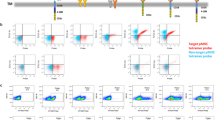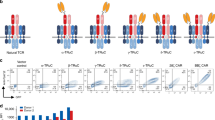Abstract
Chimeric immune receptors (CIR) encompass tumor- or virus-specific ligands or antibodies fused to the signaling domains of either the T cell receptor or Fc receptor. T cells expressing these receptors recapitulate the cytopathic effects mediated by the T cell receptor and allow the targeting of tumor or virus infected cells in an MHC-independent manner. With this technology, large numbers of T cells with redirected target specificity can be generated. To define the structural features of recombinant CIRs required for optimal function, a panel of five closely related CIRs with identical target specificity were generated. These receptors recognized HIVenv through the single chain Fv (scFv) of an anti-gp120 antibody. These scFv-ζ receptors were constructed to include alternative extracellular spacer and transmembrane protein domains derived from members of the immunoglobulin supergene family. The effect of these alternative extracellular protein domains on receptor stability, antigen affinity and T cell activity was assessed. We demonstrate that modifying the extracellular protein domains of the anti-HIVenv CIRs significantly impacted receptor stability and substrate binding affinity and that these effects, and not simply the level of cell surface expression, correlated most strongly with changes in CIR-mediated killing. These studies will aid in the rationale design of recombinant CIRs for the immunotherapy of viral infections, cancer and other diseases.
This is a preview of subscription content, access via your institution
Access options
Subscribe to this journal
Receive 12 print issues and online access
$259.00 per year
only $21.58 per issue
Buy this article
- Purchase on Springer Link
- Instant access to full article PDF
Prices may be subject to local taxes which are calculated during checkout





Similar content being viewed by others
References
Eshhar Z, Waks T, Gross G, Schindler D . Specific activation and targeting of cytotoxic lymphocytes through chimeric single chains consisting of antibody-binding domains and the gamma or zeta subunits of the immunoglobulin and T-cell receptors Proc Natl Acad Sci USA 1993 90: 720–724
McGuinness R et al. Anti-tumor activity of human T cells expressing the CC49-zeta chimeric immune receptor Hum Gene Ther (in press)
Moritz D, Wels W, Mattern J, Groner B . Cytotoxic T lymphocytes with a grafted recognition specifity for ERBB2-expressing tumor cells Proc Natl Acad Sci USA 1994 91: 4428–4432
Roberts M et al. Targeting of human immunodeficiency virus-infected cells by CD8+ T lymphocytes armed with universal T-cell receptors Blood 1994 84: 2878–2889
Stancoviski I et al. Targetting of T lymphocytes to Neu/Her-2-expressing cells using chimeric receptor single chain Fv receptors J Immunol 1993 151: 6577–6582
Hwu P et al. In vivo antitumor activity of T cells redirected with chimeric antibody/T-cell receptor genes Cancer Res 1995 55: 3369–3373
Hwu P et al. Lysis of ovarian cancer cells by human lymphocytes redirected with a chimeric gene composed of an antibody variable region and the Fc receptor gamma chain J Exp Med 1993 178: 361–366
Fitzer-Attas C, Schindler D, Waks T, Eshhar Z . Direct T cell activation by chimeric single chain Fv-Syk promotes Syk-Cbl association and Cbl phosphorylation J Biol Chem 1997 272: 8551–8557
Lustgarten J, Eshhar Z . Specific elimination of IgE production using T cell lines expressing chimeric T cell receptor genes Eur J Immunol 1995 25: 2985–2991
Moritz D, Groner B . A spacer region between the single chain antibody- and the CD3 zeta-chain domain of chimeric T cell receptor components is required for efficient ligand binding and signaling activity Gene Therapy 1995 8: 539–546
Gorny M, Gianakakos V, Sharpe S, Zolla-Pazner S . Generation of human monoclonal antibodies to human immunodeficiency virus Proc Natl Acad Sci USA 1989 86: 1624–1628
Xu J et al. Epitope mapping of two immunodominant domains of gp41, the transmembrane protein of human immunodeficiency virus type 1, using ten human monoclonal antibodies J Virol 1991 65: 4832–4838
Finer M et al. Kat: a high efficiency retroviral transduction system for primary human lymphocytes Blood 1994 83: 43–50
Olshevsky U et al. Identification of individual human immunodeficiency virus type 1 gp120 amino acids important for CD4 receptor binding J Virol 1990 64: 5701–5707
Bedzyk W et al. Immunological and structural characterization of a high affinity anti-fluorescein single-chain antibody J Biol Chem 1990 265: 18615–18620
Author information
Authors and Affiliations
Rights and permissions
About this article
Cite this article
Patel, S., Moskalenko, M., Smith, D. et al. Impact of chimeric immune receptor extracellular protein domains on T cell function. Gene Ther 6, 412–419 (1999). https://doi.org/10.1038/sj.gt.3300831
Received:
Accepted:
Published:
Issue Date:
DOI: https://doi.org/10.1038/sj.gt.3300831
Keywords
This article is cited by
-
Next-generation CAR T cells to overcome current drawbacks
International Journal of Hematology (2021)
-
Evolution of chimeric antigen receptor (CAR) T cell therapy: current status and future perspectives
Archives of Pharmacal Research (2019)
-
Quarter Century of Anti-HIV CAR T Cells
Current HIV/AIDS Reports (2018)
-
Chimeric Antigen Receptors for Cancer: Progress and Challenges
Current Stem Cell Reports (2015)
-
Chimeric antigen receptor for adoptive immunotherapy of cancer: latest research and future prospects
Molecular Cancer (2014)



